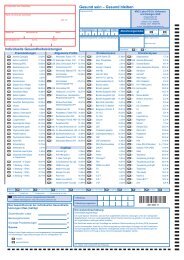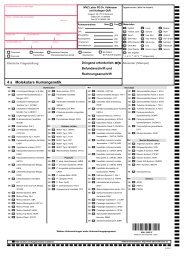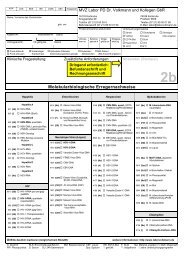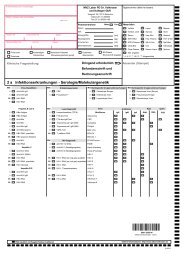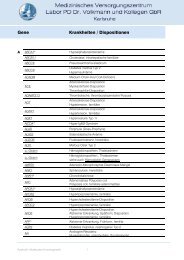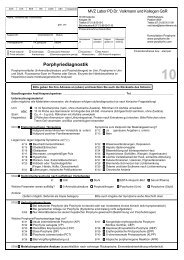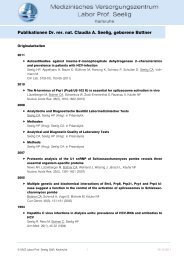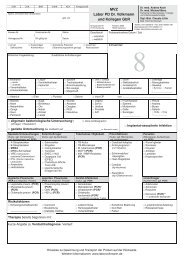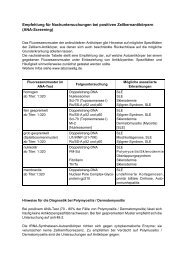ORIGINAL ARTICLE - MVZ Labor PD Dr. Volkmann und Kollegen
ORIGINAL ARTICLE - MVZ Labor PD Dr. Volkmann und Kollegen
ORIGINAL ARTICLE - MVZ Labor PD Dr. Volkmann und Kollegen
You also want an ePaper? Increase the reach of your titles
YUMPU automatically turns print PDFs into web optimized ePapers that Google loves.
thesized in E. coli BL21 Star cells (NovageneLlc) according<br />
to standard techniques and purified from inclusion<br />
bodies by Ni2 + -agarose (Quiagen, Hilden, Germany).<br />
Purity was checked after sodium dodecylsulfate<br />
polyacrylamide gel electrophoresis (SDS-PAGE) on<br />
12.5 % gels stained with Coomassie Brillant Blue.<br />
Rabbit antibodies against IM<strong>PD</strong>H2<br />
Rabbit anti-IM<strong>PD</strong>H2 were either obtained commercially<br />
(Sigma, Munich, Germany) containing 0.07<br />
mg/mL anti-IM<strong>PD</strong>H2 (anti-IM<strong>PD</strong>H2Si) or produced in<br />
house by immunization of a female New Zealand White<br />
rabbit (Charles River <strong>Labor</strong>atories, Kisslegg, Germany)<br />
with 0.3 mg His(6)-tag-IM<strong>PD</strong>H2 in PBS followed by 3<br />
injections (0.3 mg protein) within 2.5 months (anti-<br />
IM<strong>PD</strong>H2ih). Antibody synthesis was monitored on line<br />
blots spotted with His(6)-tag-IM<strong>PD</strong>H2.<br />
Antibody detection<br />
Indirect immunofluorescence test (IIFT)<br />
For antibody screening by IIFT, HEp-2 cells were cultivated<br />
on glass microscope slides for 20 hours and fixed<br />
in methanol - 20 °C, 5 minutes, acetone 20 °C, 1<br />
minute. They were incubated with patient serum diluted<br />
1:80 in PBS as described (25). For detection of bo<strong>und</strong><br />
antibodies FITC labeled rabbit anti-human-IgG, Fc specific<br />
(Invitrogen, Karlsruhe, Germany) was used in optimal<br />
dilutions determined by checker board titration. The<br />
serum of the index patient was also screened on seven<br />
different commercial HEp-2 cell preparations (Inova<br />
Diagnostics, San Diego, CA, USA; Orgentec, Mainz,<br />
Germany; Euroimmun, Lübeck, Germany; Menarini,<br />
Berlin, Germany; Generic Assays, Berlin, Germany;<br />
AESKU, Wendelsheim, Germany; AID, Straßberg, Germany).<br />
To explore a possible influence of culture time or kind<br />
of cell fixation on the intracellular localization of IMP-<br />
DH2, HEp-2 cells were harvested after growing periods<br />
of 16 – 60 hours and fixed with acetone (-20 °C, 5 minutes),<br />
methanol (-20 °C, 5 minutes), ethanol-glacial acetic<br />
acid (95:5 [vol:vol], 4 °C, 5 minutes), methanol-aceton<br />
(1:1 [vol:vol], -20 °C, 5 minutes), methanol (-20 °C,<br />
5 minutes, permeabilization by acetone at 20 °C, 1 minute)<br />
methanol-ethanol (1:1 [vol:vol], -20 °C, 5 minutes),<br />
formalin (4 %, 4 °C, 10 minutes), paraformaldehyde<br />
(4 %, 20 °C, 10 minutes, permeabilization by Triton X-<br />
100, 0.5 %, 20 °C, 10 minutes), paraformaldehyde (4 %,<br />
20 °C, 10 minutes, and methanol (-20 °C, 5 minutes),<br />
ethanol (95 %, 20 °C, 5 minutes).<br />
The effect of either mycophenolic acid or ribavirin on<br />
the intracellular localization of IM<strong>PD</strong>H2 was monitored<br />
24 hours after addition of 12.49 µmol mycophenolic<br />
acid (Sigma) or 16.38 µmol ribavirin (Sigma) to the cell<br />
culture media.<br />
AUTOANTIBODIES AGAINST IM<strong>PD</strong>H2 AND HCV INFECTION<br />
Clin. Lab. 9+10/2011 755<br />
Radioimmunoprecipitation of 35 S-methionine labeled<br />
cell proteins<br />
HEp-2 cells (5 x 10 6 ) in methionine-free medium (RP-<br />
MI1640, Sigma) were incubated with 25 µL L- 35 S-methionine<br />
(PerkinElmer, Rodgau, Germany) for 16 hours,<br />
washed (3 x in 10 mL ice cold PBS), and incubated<br />
with 3 mL of ice-cold RIP1 buffer (10 mM Tris-HCl,<br />
pH 8.0, 500 mM NaCl, 0.1 % Igepal, 2 mM PMSF) for<br />
20 minutes. Cells were harvested, sonified on ice (Sonifier<br />
Cell Disruptor B15; Branson, Danbury, CT, USA)<br />
for 3 x 30 seconds at output level 7, pulsed, 55 % duty<br />
cycle and centrifuged (4000 x g, 10 minutes). Aliquots<br />
of the supernatant containing labelled cell proteins were<br />
stored frozen at - 80 °C until used.<br />
The patient’s serum and well characterized control sera<br />
(20 µL each) were incubated with 30 µL protein-A<br />
coated magnetic beads (Invitrogen, Darmstadt, Germany)<br />
for 4 hours on a rotating mixer at 4 °C. After washing<br />
(4 x 700 µL RIP1 buffer) 100 µL 35 S-methionine<br />
labelled HEp-2 cell proteins (10 7 cpm) were added and<br />
incubated on a rotating mixer (16 hours, 4 °C). After<br />
washing as stated above the beads were heated (95 °C, 5<br />
minutes) in 30 µL sampling buffer (10 mmol Tris-HCl,<br />
pH 6.8, 2 % SDS, 2.5 % β-mercaptoethanol, 10 % glycerol,<br />
0.1 %, bromophenol blue). After brief centrifugation<br />
(10000 x g) supernatants were subjected to 9 %<br />
SDS-PAGE followed by autoradiography using Hyperfilm<br />
MP films (GE Healthcare, Munich, Germany) for<br />
24 – 48 hours.<br />
Immunoblot<br />
(1) Western blots: Separation of IM<strong>PD</strong>H2 on 12.5 %<br />
SDS-PAGE was done as described (26) in a Mini Protean<br />
II electrophoresis chamber (BioRad, Munich, Germany).<br />
Per lane 0.2 – 0.5 µg purified His(6)-tag-IM<strong>PD</strong>-<br />
H2 or commercially available IM<strong>PD</strong>H2 (0.13 mg/mL in<br />
20 mM Tris-HCl, pH 8.0, 0.5 m EDTA, 1 mM DTT;<br />
Sigma) were applied. After electrophoresis, proteins<br />
were transferred to nitrocellulose Protran BA85 membranes<br />
(VWR International, Darmstadt, Germany).<br />
Membranes were blocked in blocking buffer for 0.5<br />
hours and after washing 3 times according to Towbin et<br />
al. (27) incubated with human or rabbit sera diluted<br />
1:100 in blocking buffer for 1 hour, washed 3 times in<br />
wash buffer (10 mM Tris-HCl, pH 7.4, 150 mM NaCl,<br />
0.1 % Triton X-100) and consecutively incubated with<br />
alkaline phosphatase conjugated goat anti-human immunoglobulins<br />
(Dianova, Hamburg, Germany) or goat<br />
anti-rabbit immunoglobulins (Dianova). After washing<br />
3 times in wash buffer, bo<strong>und</strong> antibodies were visualized<br />
using BCIP with NBT as substrate.<br />
(2) Line blots were prepared by using a Nanoplotter 2.0<br />
(GeSiM, Großerkmannsdorf, Germany) with a four<br />
channel print head and applying different amounts of<br />
IM<strong>PD</strong>H2 on nitrocellulose BA85 membranes. After<br />
spotting, membranes were blocked as described above<br />
and cut in strips of 3 mm width. Routinely, protein solutions<br />
with concentrations between 12.5 µg/mL and 100<br />
µg/mL in 0.1 mol borate buffer, pH 9.0 were used for



